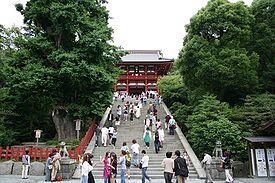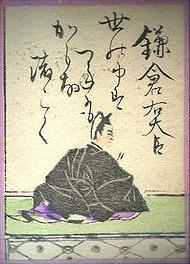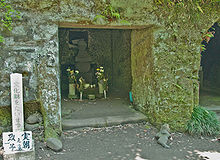- Minamoto no Sanetomo
-
 Grand stairway at Tsurugaoka Hachiman-gū in Kamakura -- the scene of Sanetomo's assassination.
Grand stairway at Tsurugaoka Hachiman-gū in Kamakura -- the scene of Sanetomo's assassination. In this Japanese name, the family name is "Minamoto".
In this Japanese name, the family name is "Minamoto".Minamoto no Sanetomo (源 実朝, September 17, 1192 – February 13, 1219, r. 1203–1219) was the third shogun of the Kamakura shogunate[1] Sanetomo was the second son of the founder of the Kamakura shogunate Minamoto no Yoritomo, his mother was Hōjō Masako, and his older brother was the second Kamakura shogun Minamoto no Yoriie.
His childhood name was Senman (千万). He was the last head of the Minamoto clan of Japan.
Contents
Life
After the death of his father Yoritomo in 1199, Sanetomo's grandfather Hōjō Tokimasa usurped all political and military power of the shogunate, relegating the position and title of Seii Taishogun, or shogun, to a mere figurehead. Through hereditary succession, Sanetomo's older brother Yoriie became Seii Taishogun in 1202, to only be stripped of the title a year later and put under house arrest for plotting against the Hōjō clan.[citation needed] Shortly thereafter in 1203, Sanetomo became head of the Minamoto clan and was appointed Seii Taishogun. In the next year, 1204, Yoriie was assassinated by the Hōjō. Sanetomo was never anything more than a puppet for his mother Hōjō Masako, who used him as a pawn in her war with Tokimasa - Tokimasa would try to depose his grandson a number of times, beginning in 1205, causing Sanetomo to fear for his life the rest of his days.[citation needed]
Sanetomo, understanding his own powerlessness in comparison to the Hōjō and not wanting to meet the same fate as his brother, put all of his time and energy into writing poetry and gaining posts within the powerless but honorary imperial court. Sanetomo was a talented poet, writing over 700 poems between the ages of 17 and 22 while being tutored by Fujiwara no Teika[citation needed], even having one of his tanka included in the anthology Ogura Hyakunin Isshu (100 Poems by 100 Poets), a noted collection of Japanese poems of the Heian and early Kamakura periods. Sanetomo also achieved the third highest post of the imperial court, Udaijin (Minister of the Right or "vice-premier") in 1218.[1] Eventually, he lapsed into inactivity and despair, plagued by fear of assassination and tormented by his chronic alcoholism (an addiction which Priest Eisai once tried to break by replacing alcohol with tea).[citation needed]
Assassination
Main article: Kugyō (Minamoto no Yoshinari)Under heavy snow on the evening of February 12, 1219 (Jōkyū 1, 26th day of the 1st month), Sanetomo was coming down from the Senior Shrine at Tsurugaoka Hachiman-gū after assisting to a ceremony celebrating his nomination to Udaijin.[2] His nephew (the son of second shogun Minamoto no Yoriie) Kugyō (Minamoto no Yoshinari) came out from next to the stone stairway of the shrine, then suddenly attacked and assassinated him.[2] For his act he was himself beheaded few hours later,[2] thus bringing the Seiwa Genji line of the Minamoto clan and their rule in Kamakura to a sudden end.
Minamoto no Sanetomo was succeeded by Kujō Yoritsune as fourth shogun of the Kamakura shogunate.
Eras of Sanetomo's bakufu
The years in which Sanetomo was shogun are more specifically identified by more than one era name or nengō.
- Kennin (1201–1204)
- Genkyū (1204–1206)
- Ken'ei (1206–1207)
- Jōgen (Kamakura period) (1207–1211)
- Kenryaku (1211–1213)
- Kenpō (1213–1219)
- Jōkyū (1219–1222)
See also
Notes
References
- Azuma Kagami, accessed on September 4, 2008; National Archives of Japan 特103-0001, Digitized image of the Azumakagami (Japanese)
- Brinkley, Frank and Dairoku Kikuchi. (1915). A History of the Japanese People from the Earliest Times to the End of the Meiji Era. New York: Encyclopædia Britannica.
- Kamiya, Michinori (2008). Fukaku Aruku - Kamakura Shiseki Sansaku, Vol. 1. (in Japanese). Kamakura: Kamakura Shunshūsha. 10-ISBN 4-7740-0340-9.
- Mass, Jeffrey P. (1995). Court and Bakufu in Japan: Essays in Kamakura History. Stanford: Stanford University Press. 10-ISBN 0-8047-2473-3; 13-ISBN 978-0-8047-2473-9
- Murray, David. (1906). Japan (Revised edition: Continuing the History to the Close of 1905, with the Provisions of the Portsmouth Treaty between Russia and Japan). New York: G. P. Putnam's Sons.
- Mutsu, Iso. (2006). Kamakura: Fact and Legend. Tokyo: Tuttle Publishing. 10-ISBN 0-8048-1968-8
- Ponsonby-Fane, Richard Arthur Brabazon. (1962). Sovereign and Subject. Kyoto: Ponsonby Memorial Society. OCLC 1014075
- Nussbaum, Louis-Frédéric and Käthe Roth. (2005). Japan encyclopedia. Cambridge: Harvard University Press. 10-ISBN 0-674-01753-6; 13-ISBN 978-0-674-01753-5; OCLC 58053128
- Titsingh, Isaac. (1834). Nihon Odai Ichiran; ou, Annales des empereurs du Japon. Paris: Royal Asiatic Society, Oriental Translation Fund of Great Britain and Ireland. OCLC 5850691.
External links
Preceded by
Minamoto no YoriieKamakura Shogun
Minamoto no Sanetomo
1203–1219Succeeded by
Kujō YoritsuneCategories:- 1192 births
- 1219 deaths
- Kamakura shoguns
- Minamoto clan
- People of Kamakura period Japan
Wikimedia Foundation. 2010.



